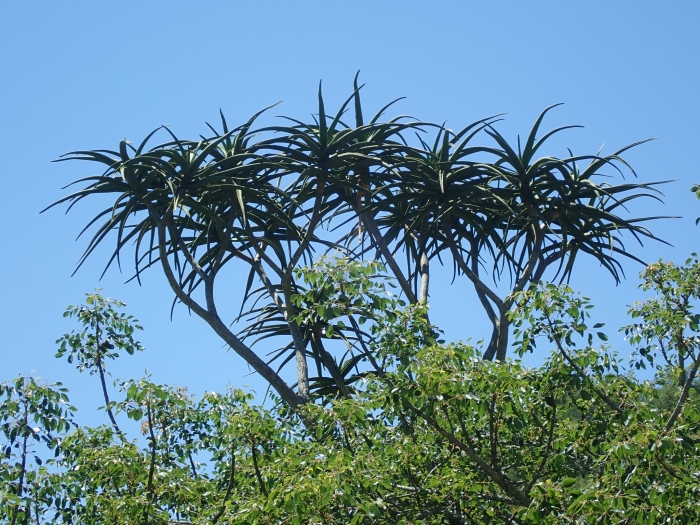Tree Aloe
(Aloidendron barberae)
Tree Aloe (Aloidendron barberae)
/
/

By Peter Warren no rights reserved
Public Domain
Image By:
By Peter Warren no rights reserved
Recorded By:
Copyright:
Public Domain
Copyright Notice:
Photo by: By Peter Warren no rights reserved | License Type: Public Domain | License URL: http://creativecommons.org/publicdomain/zero/1.0/ | Uploader: peterrwarren | Publisher: iNaturalist |














Estimated Native Range
Summary
Aloidendron barberae, commonly known as Tree Aloe, is an evergreen succulent native to the dry, rocky hills and open woodlands of southeastern South Africa. This slow-growing tree can reach up to 60 feet (18 meters) in height with a stem diameter of 36 inches (0.91 meters), making it Africa’s largest aloe-like plant. The Tree Aloe has a distinctive appearance with a thick, tapering trunk and a dense, rounded crown of gray-green leaves. Its tubular, rose pink flowers with green tips bloom in winter, attracting sunbirds which are its primary pollinators in the wild.
Tree Aloe is valued for its dramatic form and is often used as a focal point in large gardens and public landscapes. Its winter flowering season provides color during a time when few other plants are in bloom. The plant is also known for its ease of propagation, particularly from cuttings (truncheons), which should be allowed to dry before planting. It is suitable for xeriscaping and adds architectural interest to rockeries and succulent gardens. While it prefers well-drained soil, ideally on a slope, Tree Aloe can tolerate some shade when young. It thrives in full sun with low to medium water requirements and well-draining soil. Gardeners should avoid planting it in confined spaces to prevent issues with its expansive roots and trunk.CC BY-SA 4.0
Tree Aloe is valued for its dramatic form and is often used as a focal point in large gardens and public landscapes. Its winter flowering season provides color during a time when few other plants are in bloom. The plant is also known for its ease of propagation, particularly from cuttings (truncheons), which should be allowed to dry before planting. It is suitable for xeriscaping and adds architectural interest to rockeries and succulent gardens. While it prefers well-drained soil, ideally on a slope, Tree Aloe can tolerate some shade when young. It thrives in full sun with low to medium water requirements and well-draining soil. Gardeners should avoid planting it in confined spaces to prevent issues with its expansive roots and trunk.CC BY-SA 4.0
Plant Description
- Plant Type: Succulent
- Height: 18-27 feet
- Width: 10-20 feet
- Growth Rate: Moderate, Rapid
- Flower Color: Pink
- Flowering Season: Spring, Winter
- Leaf Retention: Evergreen
Growth Requirements
- Sun: Full Sun
- Water: Low, Medium
- Drainage: Medium, Fast
Common Uses
Bee Garden, Bird Garden, Butterfly Garden, Drought Tolerant, Fire Resistant, Hummingbird Garden, Low Maintenance, Rock Garden, Showy Flowers, Street Planting
Natural Habitat
native to the dry, rocky hills and open woodlands of southeastern South Africa
Other Names
Common Names:
Scientific Names: , Aloe barberae, Aloe bainesii, Aloidendron barberae, Aloe bainesii var. barberae, Aloe zeyheri,
GBIF Accepted Name: Aloidendron barberae (Dyer) Klopper & Gideon F.Sm.